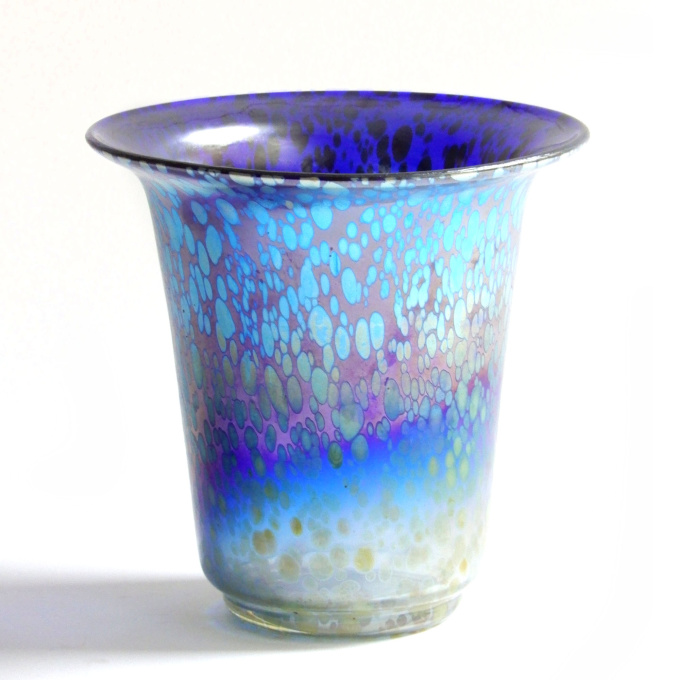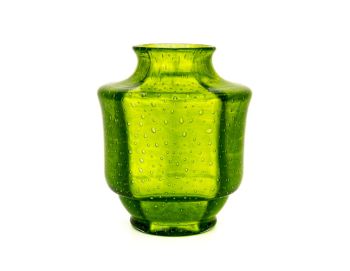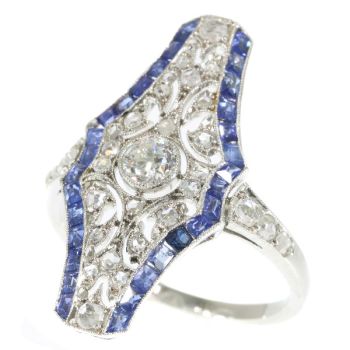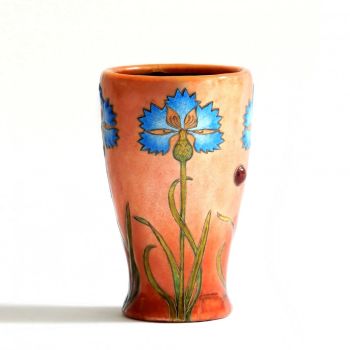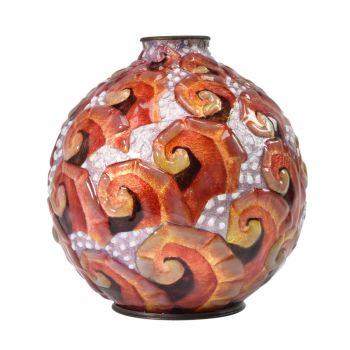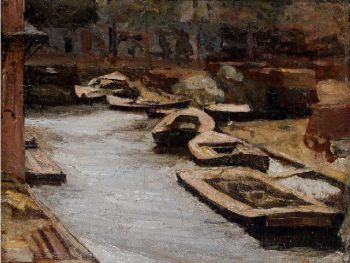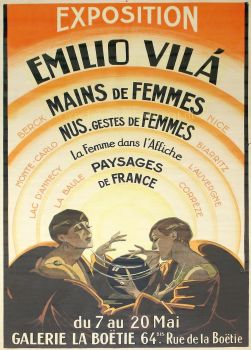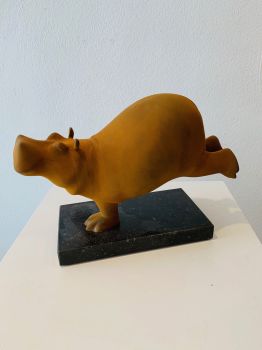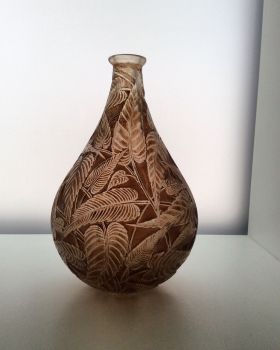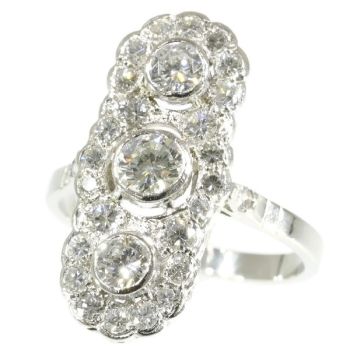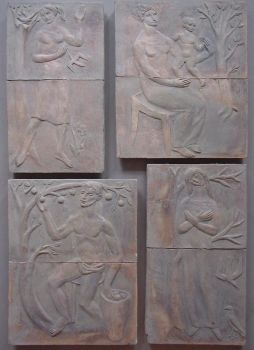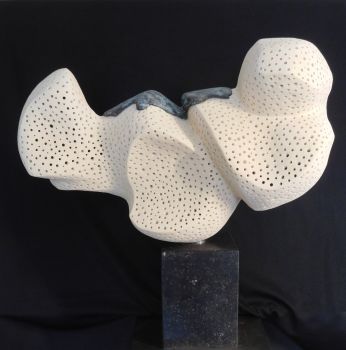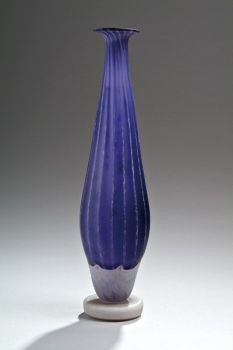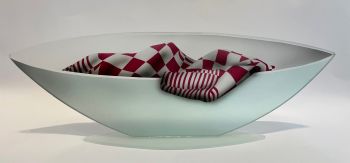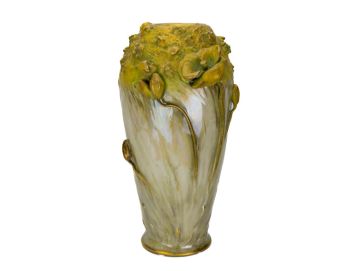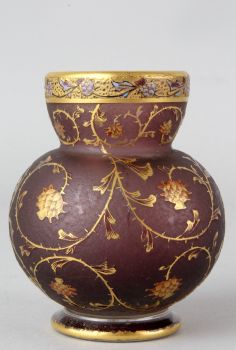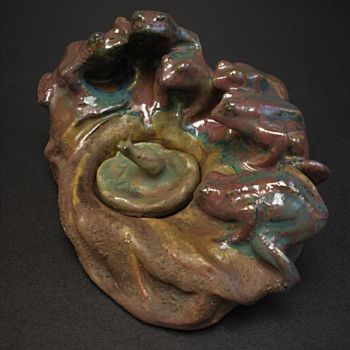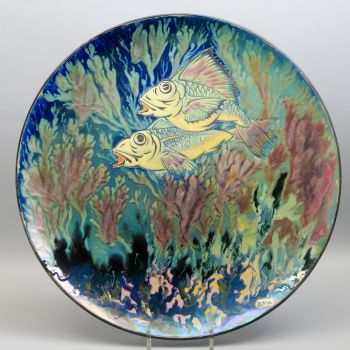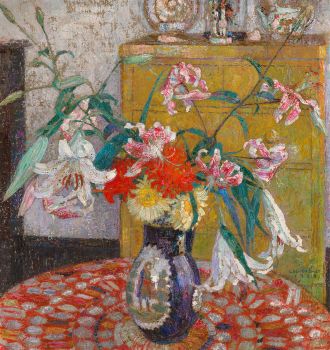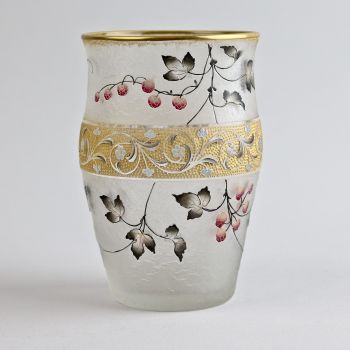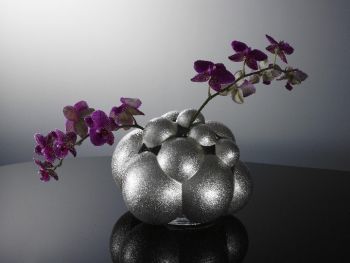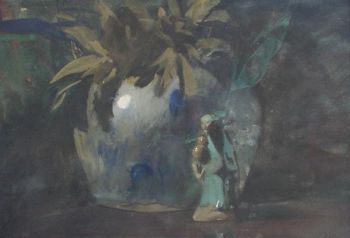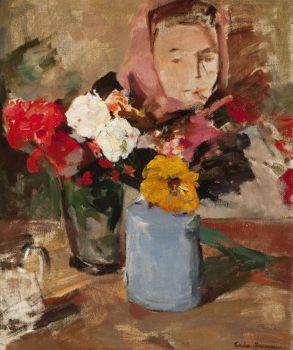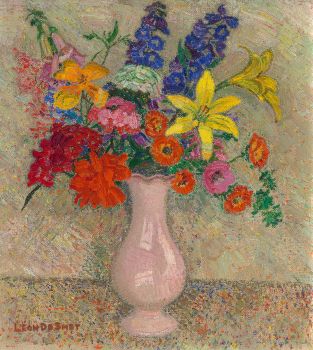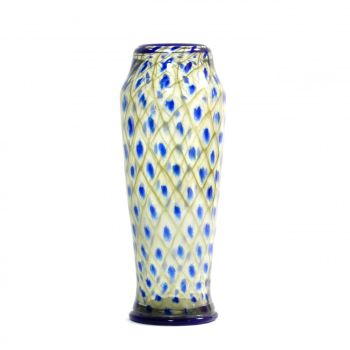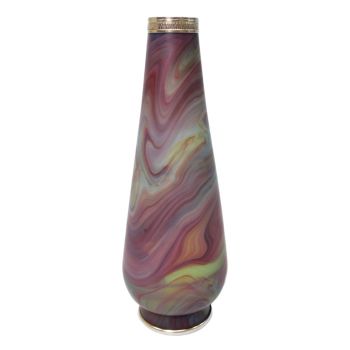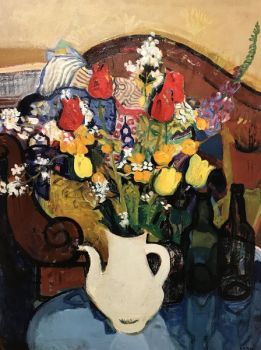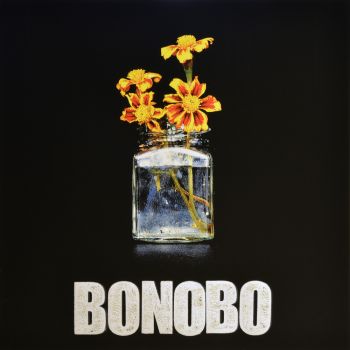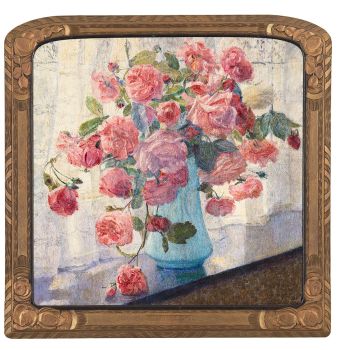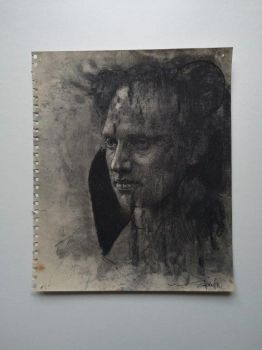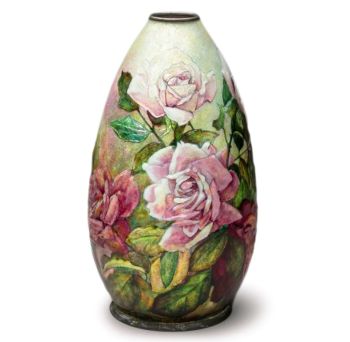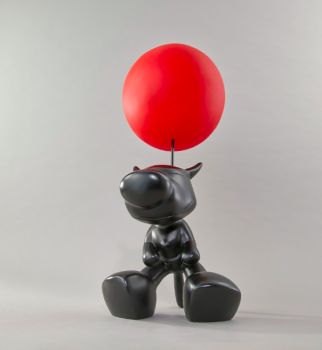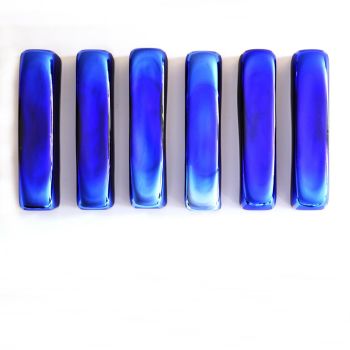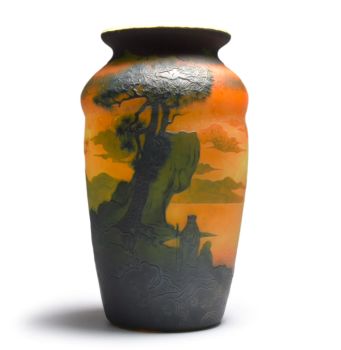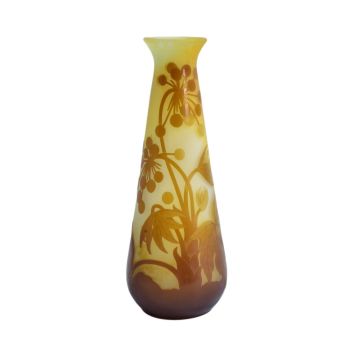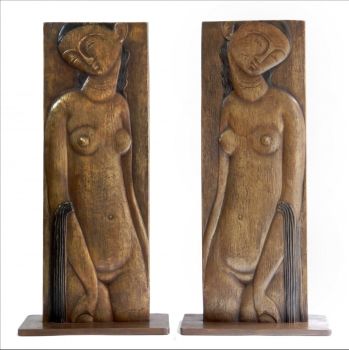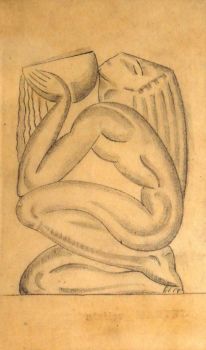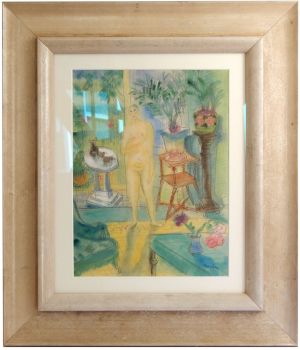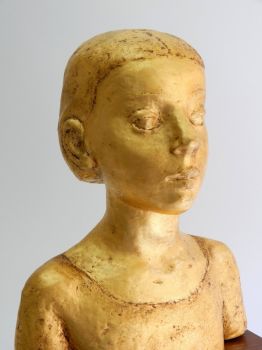Vase with papillon decor 1910 - 1920
Johann Loetz (Lötz) Witwe Klostermühle
Glas
13 cm, ø 13 cm
ConditionExcellent
Momenteel niet beschikbaar via Gallerease
Dille Art
- Over kunstwerkBeautiful vase with intense colours. The vase has a flared neck and has a papillon decor in iridescent colours, from light to deep blue, soft green-yellow and violet. The vase is in excellent condition.
About Johann Lötz Witwe:
Lötz/Loetz was founded by Johann Lötz in 1840 and the company was located in Bohemia, in the Czech Republic, at the time Lötz belonged to the Austrian-Hungarian Empire.
In 1879 a grandson of Lötz, Max Ritter-Von Spaun, took over the business from his grandmother, he kept the name Joh. Lotz Witwe.
From that moment on, Johann Lötz Witwe really started to make a name for themselves, they developed new innovative glass techniques, but their design and the bright colours were also completely innovative. They designed special shapes and vases, high end items, which they sold in luxury stores in Vienna, Berlin, Hamburg, Paris, London, Milan, Brussels and Madrid. It soon made them very well known and famous.
It was the period when Art Nouveau or, as it was called in Germany, Jugendstil flourished. They used organic shapes, nature was their example, also for Lötz. They developed beautiful decors, resembling butterfly wings, such as the papillon decor of this vase, often the shapes were organically formed by unevenly shaping the hot glass with tongs, as also flowers are formed. But an octopus or sea shells were also used as examples for their special vases and decors.
Lötz took part in all kinds of World Exhibitions, including the famous 1900 World Exhibition in Paris where they won the grand prize. They have been awarded numerous prizes for participation in World Exhibitions. Max Ritter von Spaun also received special awards for his contribution to the glass industry. In 1883 he was allowed to use the Imperial eagle in their shield and seal, they were also allowed to put "K.K. Private Glass Factory" in front of their name. In 1889 he also received a knighthood from Franz Josef. But other royal houses also did not go unnoticed, he received the Belgian Leopold's order, and the honourable French Legion d'Honneur.
Their designs were loved, including in the United States. Lötz patented some of their special techniques, such as the one they used to make the Phänomen decor. They were able to make iridescent glass. In short, Lötz had become a household name. And it still is.
Lötz also worked closely with other glass manufacturers such as J.&L. Lobmeyer and E. Bakolowits Söhne in Vienna and with Argentor. In addition, Lötz worked closely with various artists, such as Josef Hoffmann, Koloman Moser, Franz Hofstötter, Michael Powolny and other artists of the Wiener Werkstätte. Michael Powolny was responsible for the more stylized tango vases from the 1920s.
The First World War and the end of the Austrian Empire marked a difficult period for Lötz.
Lötz existed until 1940, after a bombing raid the factory was completely burned down. After WWII, the Czech Republic belonged to the satellite states of the Soviet Union, the factory was nationalized, until it was finally closed in 1947.
Lötz glass is still very popular and is collected worldwide, their oeuvre can also be found in many museum collections.
Literature:
- Guiseppe Gappa; 'Le génie verrier de l'Europe', p. 95-107. Pierre Mardaga, Belgique, 1998, p. 95-107.
- Victor Arwas, 'Glass, Art Nouveau to Art Deco', p. 202-212. Academy Editions London 1987,
p. 202-212.
- 'Das Böhmische Glas 1700-1950', Passauer Glasmuseum, Georg Höltl, Passau 1995.
Band IV: Jugendstil in Böhmen, p. 16-133, afbeelding p.57, fig.IV.76.
- Victor Arwas, 'Glass, Art Nouveau to Art Deco', p 202-212. Academy Editions London, 1987. - Over kunstenaar
Lötz/Loetz werd in 1840 opgericht door Johann Lötz en was een bedrijf gevestigd in Bohemen, in de Tsjechische Republiek, in de tijd dat Lötz tot het keizerrijk Oostenrijk-Hongarije behoorde. In 1879 nam een kleinzoon van Lötz, Max Ritter-Von Spaun, de zaak over van zijn grootmoeder en hield de naam Joh. Lötz Witwe.
Vanaf dat moment begon Johann Lötz Witwe echt naam te maken, ze ontwikkelden nieuwe innovatieve glastechnieken, maar ook hun vormgeving en felle kleuren waren helemaal vernieuwend. Ze ontwierpen bijzondere vormen en vazen, luxe artikelen, die ze verkochten in luxe winkels in Wenen, Berlijn, Hamburg, Parijs, Londen, Milaan, Brussel en Madrid. Het maakte ze al snel zeer bekend en beroemd.
Het was de periode dat de Art Nouveau of zoals dat in Duitsland Jugendstil genoemd werd, bloeide. Ze gebruikten organische vormen, de natuur was hun voorbeeld, ook voor Lötz ontwikkelden ze prachtige decors, gelijkend op vlindervleugels, zoals het papillondecor van deze vaas, vaak werden de vormen organisch gevormd door met een tang het hete glas ongelijk te vormen, evenals bloemen worden gevormd. Maar ook een octopus of zeeschelpen werden als voorbeeld genomen voor hun bijzondere vazen en decors.
Lötz nam deel aan allerlei Wereldtentoonstellingen, waaronder de beroemde Wereldtentoonstelling van 1900 in Parijs waar ze de Grote Prijs wonnen. Ze werden bekroond met tal van prijzen voor deelname aan Wereldtentoonstellingen. Max Ritter von Spaun ontving ook speciale onderscheidingen voor zijn bijdrage aan de glasindustrie, in 1883 mocht hij de keizerarend in hun schild en zegel gebruiken, ze mochten ook K.K. Zet Private Glass Factory voor hun naam. In 1889 ontving hij ook een ridderschap van Franz Josef. Maar ook andere koningshuizen waren erbij betrokken. Hij ontving de Belgische Leopoldsorde en het eervolle Franse Legion d'Honneur.
Hun ontwerpen vielen in de smaak, ook in de Verenigde Staten. Tiffany werkte met Lötz aan de set van Favril. Lötz patenteerde enkele van hun speciale technieken, zoals degene die ze gebruikten om het Phänomen-decor te maken. Ze waren in staat iriserend glas te maken. Kortom, Lötz was een begrip geworden. En dat is het nog steeds.
Lötz werkte ook nauw samen met andere glasfabrikanten zoals J.&L. Lobmeyer en E. Bakolowits Söhne in Wenen en met Argentor. Daarnaast werkte Lötz nauw samen met verschillende kunstenaars, zoals Josef Hoffmann, Koloman Moser, Franz Hofstötter, Michael Powolny en andere kunstenaars van de Wiener Werkstätte. Michael Powolny was verantwoordelijk voor de veel strakkere tangovazen uit de jaren twintig.
De Eerste Wereldoorlog en het einde van het Oostenrijkse rijk betekenden een moeilijke periode voor Lötz.
Lötz heeft bestaan tot 1940, na een bombardement is de fabriek volledig afgebrand. Na de Tweede Wereldoorlog behoorde Tsjechië tot de satellietstaten van de Sovjet-Unie, de fabriek werd genationaliseerd totdat deze uiteindelijk in 1947 werd gesloten.Het glas van Lötz is nog steeds erg populair en wordt wereldwijd verzameld, daarnaast is hun oeuvre ook terug te vinden in vele museumcollecties.
Bent u geïnteresseerd om dit kunstwerk te kopen?
Artwork details
Related artworks
Johann Loetz (Lötz) Witwe Klostermühle
Johann Loetz Witwe - Phänomen Genre 7773 – Orange1900 - 1910
Prijs op aanvraagAntiques Emporium
Johann Loetz (Lötz) Witwe Klostermühle
Johann Loetz Witwe – Jugendstil Cobalt Papillon vaas1900 - 1910
Prijs op aanvraagAntiques Emporium
1 - 4 / 8Amalric Walter
Amalric Walter & Henri Bergé – Crabe plumier1920 - 1929
Prijs op aanvraagAntiques Emporium
1 - 4 / 24Onbekende Kunstenaar
A large Japanese Imari porcelain 'VOC Groningen' dish1800 - 1925
Prijs op aanvraagZebregs & Röell - Fine Art - Antiques
Onbekende Kunstenaar
Gevleugelde Venetiaanse Beker1624 - 1626
Prijs op aanvraagPeter Korf de Gidts - Antiquairs
Gyrinus
Stippen gegraveerd glas met putti1764 - 1766
Prijs op aanvraagPeter Korf de Gidts - Antiquairs
1 - 4 / 24Jan Voerman sr
Stilleven met bloemen in een Chinees beeldje1850 - 1900
Prijs op aanvraagKunsthandel Pygmalion
Herman Bogman jr.
Flower still life of a nasturtium in a blue vase1950 - 1965
Prijs op aanvraagAdelwein Kunst
1 - 4 / 24Onbekende Kunstenaar
Gevleugelde Venetiaanse Beker1624 - 1626
Prijs op aanvraagPeter Korf de Gidts - Antiquairs
Onbekende Kunstenaar
Cristallo façon de Venise Drinkglas1600 - 1650
Prijs op aanvraagPeter Korf de Gidts - Antiquairs
Johann Loetz (Lötz) Witwe Klostermühle
Johann Loetz Witwe - Phänomen Genre 7773 – Orange1900 - 1910
Prijs op aanvraagAntiques Emporium
Onbekende Kunstenaar
Een zeldzame filigrana a retortoli bokaal1550 - 1600
Prijs op aanvraagPeter Korf de Gidts - Antiquairs
1 - 4 / 24- 1 - 4 / 12

